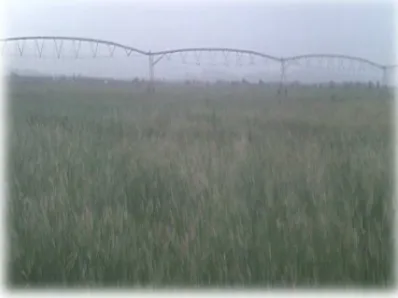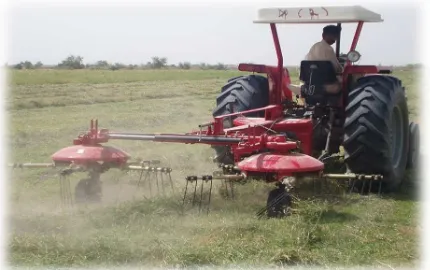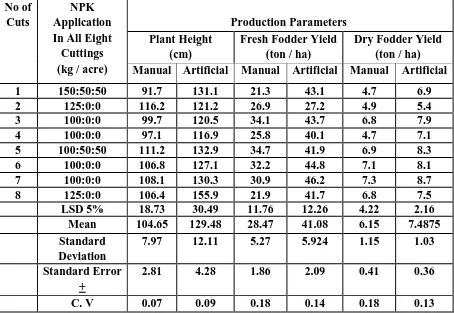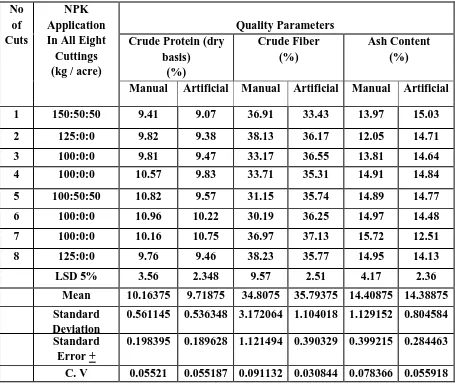Effect of Manual and Artificial Application of
NPK Fertilizers on the Growth and Yield of
Rhodes Grass (Chloris Gayana L. Kunth.) by
Using Central Pivot Irrigation Technology
Imran Arshad1, Zaheer Ahmed Khan2& Khalid Mohammed Medani3
1Agriculture Engineer, Abu Dhabi Farmers’ Services Centre (ADFSC), Abu Dhabi –
Western Region, UAE.
2Lecturer, Faculty of Agriculture Engineering, Sindh Agriculture University (SAU),
Tandojam, Sindh – Pakistan.
3Country Manager, Aldahra Agriculture Company PVT Ltd, Rhodes Grass Project,
Karachi, Sindh – Pakistan.
1Corresponding author’s e-mail: engr_imran1985@yahoo.com
Abstract
The present research work was conducted to find out the Rhodes grass response to manual and
artificial application of NPK
fertilizers by using central pivot irrigation technology in available
agro-ecological conditions of
Nooriabad, Sindh, Pakistan. In this study the quality and production parameters were studied for the safe keeping of the Rhodes grass. Green fodder in hay form is much more popular around the globe especially in UAE and Gulf Regions. And among all fodder grasses the Rhodes grass is becoming popular with the every passing day. It has high protein value (9-13%) and the average water consumption for Rhodes Grass production is about 600 mm to 1200 mm. As the Rhodes Grass crop gives the yield for
multiple years therefore, extra
ordinary care of farming operations are required. Arid regions where summer comes early the Rhodes Grass sowing can be done from March to April and August to September. One time sowing of
Rhodes grass will give the
production to the growers for more than three years.
EFFECT OF MANUAL AND ARTIFICIAL APPLICATION OF NPK FERTILIZERS ON THE GROWTH AND YIELD OF RHODES GRASS (CHLORIS GAYANA L. KUNTH.) BY USING CENTRAL PIVOT IRRIGATION TECHNOLOGYImran Arshad, Zaheer Ahmed Khan & Khalid Mohammed Medani
fodder yield and the means of (crude protein %, Crude Fiber % and Ash %) were calculated accordingly. The mean average yield of dry Rhodes grass hay per cut obtained from manual and artificial application of fertilizers is around 6.15 ton / ha and 7.4875 ton / ha respectively. The minimum plant height for Block A and Block B in all eight cuttings recorded to be 91.7 cm and 116.9 cm respectively. Similarly the maximum plant height for Block A and Block B in all eight cuttings recorded to be
116.2 and 155.9 respectively.
Statistical analysis of all the research data i.e. the coefficient of variation (C.V), Standard Error (S.E), LSD,
and standard deviation for
production and quality parameters are elaborated in table 4 and table 5 respectively.
Keywords: Rhodes Grass, Central
Pivot Irrigation System,
Hay, Agriculture,
Fertilizer Application.
INTRODUCTION
It is imperative for the inhabitants of every part of the universe to envisage diverse techniques, based on research work with proven results to augment the agriculture sector in terms of yield enhancement, proper fertilizer application, plant protection and above all water management strategy in view of
upcoming water shortages around the globe. A sizeable part of our planet is very dry, which cannot be irrigated by conventional method i.e. through proper irrigation system and the incessant booming flux of population has further aggravated the scenario in question. I t entails in educating the people to produce their own food for them and their generations to come with the available techniques are so diverse that a very large volume would cover the entire subject (Franklin et al 1998).
cannot be further increased due to growing of other commodity crops (Qamar, 1997).
It is further pointed out that green fodder in hay form is much more popular around the globe especially in UAE and Gulf Regions. And among all fodder grasses the Rhodes grass is becoming popular with the every passing day. The grass may be cultivated in tropical and subtropical area and by nature it is perennial. It has high protein value (9-13%) and the average water consumption for Rhodes Grass production is in between 600 mm to 1200 mm (Imran 2012). It can be sown any time during the year, excluding very cold and very hot weather conditions. The best temperature is 35o C. The
modern irrigation system suits a lot in growing the grass. A fine moist and even leveled seedbed is a prerequisite to ensure good
germination process
(www.selectedseeds.com.au).
Although Rhodes grass can be grown in diverse soil, but loose textured soil having pH range 5.0 and 8.3 are ideal soil for germination and the test yield (Valenzuela et al 2002). Rhodes grass stem is fine and leafy and its height may be uptill 0.5–2 m. The dimensions of leaf may be 15–50 cm long and 3–9 mm wide (NRCS, 2009). As the Rhodes Grass crop gives the yield for multiple years therefore, extra ordinary care
of farming operations are required. The per acre per year, yield of all cuts will give the production for about 400 to 600 Monds. Arid regions where summer comes early the Rhodes Grass sowing can be done from March to April and August to September. The irrigation should be done according to the soil and climatic conditions accordingly. One time sowing of Rhodes grass will give the production to the growers for more than three years (Imran 2012).
Keeping the above facts in view, the subject study was conducted at Nooriabad by focusing the Rhodes grass response to manual and artificial application of NPK fertilizers in available agro-ecological conditions.
OBJECTIVES
EFFECT OF MANUAL AND ARTIFICIAL APPLICATION OF NPK FERTILIZERS ON THE GROWTH AND YIELD OF RHODES GRASS (CHLORIS GAYANA L. KUNTH.) BY USING CENTRAL PIVOT IRRIGATION TECHNOLOGYImran Arshad, Zaheer Ahmed Khan & Khalid Mohammed Medani
MATERIALS AND
METHODS
Location
The comparative study of manual and artificial application of NPK fertilizers pertaining to Rhodes grass yield and growth in arid region of Nooriabad – Sindh Pakistan, at Jahanzaib Farms was conducted. This farm is located 68 KM away from Karachi on Main Karachi – Hyderabad Super Highway. The study work was started on March 09, 2013.
Farm Size and Topographical Conditions
This farm is stretched over 193 acres, on 40 acres wheat has been cultivated and 20 acres are having vegetables and fruits. About 133 acres of the land was fallow and from which 50 acres of land was selected for growing Rhodes grass to carry out research work / study work. The topographic condition of the subject selected land (area of interest - AOI) was not even as it was having small aggregates on the surface and large aggregates in the subsurface after 10 inches from the topsoil. Some portion was having sediments due to adjacent hilly areas. Ample quantity of extra grass and weeds were also present in same portion of AOI. The only water source was groundwater and central pivot
irrigation system was commissioned to achieve complete irrigation of 50 acres with the discharge of 801 GPM.
Experimental Setup
In order to achieve the research objectives initially the land was divided into two blocks and soil samples from these blocks were collected to carry out further tests along with water samples from bore 1 and bore 2 accordingly. Then the weeds and extra grass were cleared by using 2 - 4 split crosswise cultivator operations supplemented with disk harrow in order to ensure uniform distribution of irrigation water. The land was leveled by laser leveler to prepare good seedbed in
order to ensure effective
germination. After leveling pre- irrigation of 25.4 mm / acre of irrigation water was supplied in order to observe re-growth of grass and weeds. Then after 4-5 days the grown weeds and grass were cleared by using cultivator and tooth harrow operation accordingly.
Table – 1: Analysis Results of Soil (at 6 inch depth on composite basis)
*Bloc k No.
pH at 25o C
EC SAR Nitrogen Phosphoru s Potassiu m Soil Textur e
1 7.31 1.37 ds/ 0.50
114.5 8 kg/ ha
75.93 kg /
ha
318.2 5 kg /
ha
Loam y Sand
2 7.27
1.31
ds/ 0.47
123.3 3 kg/ ha
71.48 kg /
ha
315.9 0 kg /
ha
Loam y Sand
3 7.43
1.26
ds/ 0.50
121.5 2 kg/
71.74 kg /
317.8 4 kg /
Loam y
4 7.37 1.35 ds/ 0.49
118.9 5 kg/ ha
73.39 kg /
ha
317.4 3 kg /
ha
Loam y Sand
5 7.24
1.33
ds/ 0.52
115.6 7 kg/
73.84 kg /
316.9 6 kg /
Loam y
* 1 Block is equal to 10 acres.
Table – 2: Analysis Results of Water
Bor
e pH at 25o C
EC SAR CaCO3 HCO3 TDS
1 7.16 1.11 ds/ 1.89
215.8 9 Mg/ L 172.4 5 Mg/ L 664.8 1 Mg/ L
2 7.18
1.15 ds/ 1.91 216.1 6 Mg/ 173.0 9 Mg/ 665.6 7 Mg/
The lab analysis results confirmed that the subject land contains low organic matter ensuingly 4 tons / acre organic matter (cow dung), was mixed to improve organic matter and water retention. The cow dung was mixed by the help of tractor with front and rear blade implement and left for 3 days.
EFFECT OF MANUAL AND ARTIFICIAL APPLICATION OF NPK FERTILIZERS ON THE GROWTH AND YIELD OF RHODES GRASS (CHLORIS GAYANA L. KUNTH.) BY USING CENTRAL PIVOT IRRIGATION TECHNOLOGYImran Arshad, Zaheer Ahmed Khan & Khalid Mohammed Medani
given to Block B to irrigate and fertilize the remaining 25 acres of land. Same procedure of fertilizer application is applied in all cuttings in order to get precise results accordingly. The different doses of NPK fertilizers were applied in all eight cuttings that are 150-50-50, 125-0-0, 100-0-0, 100-0-0, 100-50-50, 100-0-0, 100-0-0, and 125-0-0 respectively.
Fig. 1b. Seedbed after germination
Fig. 1c. Rhodes Grass at 10% flowering
Fig. 1d. Cutting operation with Mover Machine
About 12 mm irrigation water / acre supplied to all 50 acres. The speed of central pivot irrigation system was 50% and the total consumed time of 1 complete cycle was 12.4 hours. One day gap was given as the condition of soil was almost moist. Afterwards on alternate day’s irrigation of about 10 mm were given to all 50 acres till germination took place. After ten days the germination process completed with the emergence of grass shoot from
the seedbed. The total water consumption and split doses are given in table 3 and table 4 respectively. During and after each cut in order to get precise results the plant height, fresh fodder yield, dry fodder yield and the means of (crude protein %, Crude Fiber % and Ash %) were calculated accordingly. Data analysis and statistical analysis
were done through ANOVA
procedure. Figure 1a - 1f describes the overall farming operations which were studied during this research period.
Fig. 1e. Racking Operation
Fig. 1f. Pressing of bales with Bailer machine
RESULTS AND DISCUSSION
The complete study comparison of manual and artificial application of fertilizer in terms of growth and yield of Rhodes grass was monitored. The outcome of study revealed that plant height, quality of hay, water consumption, growth and yield differed very significantly between manual and artificial application of NPK fertilizers. The study period is from March 2013 to February 2014 and 08 (eight) cuttings from each Block i.e. A and B has been obtained. The mean average yield of dry Rhodes grass hay per hector per cut obtained from Block A and Block B is 6.15 ton / ha and 7.4875 ton / ha respectively. The total water consumption in all eight cuttings has been given below in Table - 3: and split applications of different fertilizers given to land are elaborate in table – 4. After 45 days the sown grass is fully grown and ready for 1st cutting. At this stage the following observations were recorded.
1. Plant height (ft)
2. Production per acre per cut (Fresh fodder and dry Fodder)
EFFECT OF MANUAL AND ARTIFICIAL APPLICATION OF NPK FERTILIZERS ON THE GROWTH AND YIELD OF RHODES GRASS (CHLORIS GAYANA L. KUNTH.) BY USING CENTRAL PIVOT IRRIGATION TECHNOLOGYImran Arshad, Zaheer Ahmed Khan & Khalid Mohammed Medani
Table – 3: Quantity of water (irrigation plus rainfall) applied to Rhodes Grass for all 50 acres during -2013/2014.
No. of Cuttings
Period of Growth (March 2013 – March 2014)
Days of Maturity
(Days)
Quantity of water applied
(mm)
1 March 9 to April 23 45 258.67
2 April 23 to June 04 42 201.71
3 June 04 to July 13 39 210.88
4 July 13 to August 17 35 218.83
5 August 17 to October 01 45 226.77
6 October 01 to Novemb er 19 50 204.81
7 November 19 to Janu ary 15 57 196.72
8 January 15 to March 7 51 186.35
Table – 4: The effect of NPK fertilizers on plant height, fresh and dry yield during -2013/2014
No of Cuts
NPK Application In All Eight Cuttings (kg / acre)
Production Parameters Plant Height
(cm)
Fresh Fodder Yield (ton / ha)
Dry Fodder Yield (ton / ha) Manual Artificial Manual Artificial Manual Artificial
1 150:50:50 91.7 131.1 21.3 43.1 4.7 6.9
2 125:0:0 116.2 121.2 26.9 27.2 4.9 5.4
3 100:0:0 99.7 120.5 34.1 43.7 6.8 7.9
4 100:0:0 97.1 116.9 25.8 40.1 4.7 7.1
5 100:50:50 111.2 132.9 34.7 41.9 6.9 8.3
6 100:0:0 106.8 127.1 32.2 44.8 7.1 8.1
7 100:0:0 108.1 130.3 30.9 46.2 7.3 8.7
8 125:0:0 106.4 155.9 21.9 41.7 6.8 7.5
LSD 5% 18.73 30.49 11.76 12.26 4.22 2.16 Mean 104.65 129.48 28.47 41.08 6.15 7.4875 Standard
Deviation
7.97 12.11 5.27 5.924 1.15 1.03
Standard Error +
2.81 4.28 1.86 2.09 0.41 0.36
Thairu and Tessema (1985) reported that regular application of fertilizers is imperative to ensure maximal yield as this crop is heavy yielder which warrants heavy doses of fertilizers even if the soil is normal and rainfall conditions are good. The best fertilizers for the crops are nitrogen supplemented with Phosphorous and Pottasium due to their yield and crude protein display and linear responses. After every cut 275 – 400 kg / ha is a recommended fertilizers to be applied to host the next cut to be accelerated. From figure 2a, 2b and 2c we can understand the response of plant height and productivity of Rhodes grass against the fertilizer doses applied in all eight cuts.
EFFECT OF MANUAL AND ARTIFICIAL APPLICATION OF NPK FERTILIZERS ON THE GROWTH AND YIELD OF RHODES GRASS (CHLORIS GAYANA L. KUNTH.) BY USING CENTRAL PIVOT IRRIGATION TECHNOLOGYImran Arshad, Zaheer Ahmed Khan & Khalid Mohammed Medani
Fig. 2b. Comparison of manual vs artificial application of NPK of all eight cuts in terms of fresh fodder yeild (tons / ha).
Fig. 2c. Comparison of manual vs artificial application of NPK of all eight cuts in terms of dry fodder yeild (tons / ha).
From figure. 2a, 2b and 2c it is clear that the artificial application of
application as the coefficient of variation (C.V), standard error (S.E), and standard deviation shows higher values from production point of view, for block A as compared to block B.
Quality of a forage grass for animal consumption is imperative. All the requisite essential nutrients must be available in sufficient quality. Generally, if animals are fed with adlib green forages, grown under good management and cut, at correct stage, it can be guaranteed that the animal might take up most of the essential nutrients in sufficient quantities. Proper management practice together with correct application of fertilizer, irrigation in drought spells, cutting at the suitable height and interval is essential for maximum profit and persistence of crop (Premaratne et al 2006).
In Rhodes grass the contents of organic compounds usually vary as follows: crude protein 9 – 13 percent, crude fibre 30 – 40 percent, ether extract 0.8 – 1.5 percent, nitrogen free extract 42 – 48 percent (Bogdan, 1969). If the forages are
EFFECT OF MANUAL AND ARTIFICIAL APPLICATION OF NPK FERTILIZERS ON THE GROWTH AND YIELD OF RHODES GRASS (CHLORIS GAYANA L. KUNTH.) BY USING CENTRAL PIVOT IRRIGATION TECHNOLOGYImran Arshad, Zaheer Ahmed Khan & Khalid Mohammed Medani
Table – 5: The effect of different fertilizers on crude protein, crude fiber and ash content during -2013/2014.
No of Cuts
NPK Application In All Eight Cuttings (kg / acre)
Quality Parameters Crude Protein (dry
basis) (%)
Crude Fiber (%)
Ash Content (%)
Manual Artificial Manual Artificial Manual Artificial
1 150:50:50 9.41 9.07 36.91 33.43 13.97 15.03
2 125:0:0 9.82 9.38 38.13 36.17 12.05 14.71
3 100:0:0 9.81 9.47 33.17 36.55 13.81 14.64
4 100:0:0 10.57 9.83 33.71 35.31 14.91 14.84
5 100:50:50 10.82 9.57 31.15 35.74 14.89 14.77
6 100:0:0 10.96 10.22 30.19 36.25 14.97 14.48
7 100:0:0 10.16 10.75 36.97 37.13 15.72 12.51
8 125:0:0 9.76 9.46 38.23 35.77 14.95 14.13
LSD 5% 3.56 2.348 9.57 2.51 4.17 2.36
Mean 10.16375 9.71875 34.8075 35.79375 14.40875 14.38875
Standard Deviation
0.561145 0.536348 3.172064 1.104018 1.129152 0.804584
Standard Error +
0.198395 0.189628 1.121494 0.390329 0.399215 0.284463
C. V 0.05521 0.055187 0.091132 0.030844 0.078366 0.055918
SUMMARY AND CONCLUSIONS
The subject study was conducted in arid region of Nooriabad Sindh, Pakistan in order to observe the comparative merits and demerits of manual and artificial application of NPK fertilizer to Rhodes grass in term of growth, yield and nutrition value. On the basis of results and
A and Block B in all eight cuttings recorded to be 91.7 cm and 116.9 cm respectively. Similarly the maximum plant height for Block A and Block B in all eight cuttings recorded to be 116.2 and 155.9 respectively. The coefficient of variation (C.V), Standard Error (S.E), and standard deviation shows higher values from production point of view, for block A as compared to block B, which might be due to non-uniform distribution of fertilizers in all eight cuttings. In addition to this in Block A, some bold granules was found during cleaning of the field which may be because the fertilizers applied was not properly mixed with water and this may be one of the reason that the plan height and production achieved from this block is less as compared to the block B.
Similarly the coefficient of variation (C.V), Standard Error (S.E), and standard deviation shows higher values from quality point of view, for block A as compared to block B. However the Crude protein obtained higher values in all eight cuttings for block A, which might be due to the small plant height as compared to the plants grown in block B. But still the percentage of Crude Protein we obtained in both blocks was within limit i.e. greater than 9% which is acceptable in the case of Rhodes Grass. As we know that if the plants height will be more the Crude Protein content in that plant will be
less that’s why it is recommended to cut the grass at 10% flowering. So in order to safe protein level and get optimum production.
It has also been observed that as fertilizers had been applied to the Rhodes grass in block B through central pivot irrigation system the majority of this being absorbed by the leaves and they look more lush green as compared to the grass grown in Block A this is because the leaves have transcuticular pores both on upper and lower leave surfaces (i.e. pores between cell structures) and stomata through which nutrient sprays can enter the plant. In fact, it is becoming a popular practice to apply fertilizers to the grass as it quick and less time consuming as compared to the normal uptake of fertilizers through root zone. It has also been observed that during the 5th cut production the grass is fertilize with split doses Phosphorous and Potassium due to which the plant height and productivity enhance.
EFFECT OF MANUAL AND ARTIFICIAL APPLICATION OF NPK FERTILIZERS ON THE GROWTH AND YIELD OF RHODES GRASS (CHLORIS GAYANA L. KUNTH.) BY USING CENTRAL PIVOT IRRIGATION TECHNOLOGYImran Arshad, Zaheer Ahmed Khan & Khalid Mohammed Medani
irrigation water simultaneously which entail in saving the labor charges associated with fertilizer spreading in the field. However
modern system demands for
continuous water supply for even functioning of equipments involved.
SUGGESTIONS
As Rhodes Grass is an export cash crop, the farmers and growers are inclined to grow it on vast scale especially in arid ecological zones of the world. It is suggested that it must be grown under the supervision
of qualified consultants
(agriculturists) in order to ensure excellent crop and yield which may entail in earning handsome foreign exchange by its export (Imran, 2012). The area under study was loamy sand; therefore these suggestions are applicable for only loamy sand soils while the results may vary for other types of soil.
ACKNOWLEDGEMENTS
The authors wish to express their gratitude to Jehangir Farm
Nooriabad, representatives
especially to Mr. Shafiq-ur-Rehman and Mr. Aftab Ahmed for their kind assistance throughout the study and all other individuals who have been source of help throughout the research period.
REFERENCES
1. A. M. Yossif, Y. M. Ibrahim (2013) “Effect of Fertilizers (Urea, Farmyard and Chicken Manure) on Growth and Yield of Rhodes Grass (Chloris Gayana L. Knuth.)”. Universal Journal of Plant Science 1(3): 85-90, 2013 http://www.hrpub.org DOI: 10.13189/ujps.2013.010305.
2. I. Arshad (2012) “Green Fodder – A Critical Resource” published in SGS Pakistan Pvt. Ltd. News Letter Pg. 03 - September 2012.
3. M. Arshad, A. Razzaq, R.Saleem (2006) “Performance of Various Forage Grasses under spring and Monsoon Seasons at Pothowar Plateau (Pakistan)”. International journal of Agriculture and Biology, 1560–8530/2006/08–3–398–401. 4. Mirza, S.N., N. Mohammad and I.A.
Qamar, (2002). Effect of growth stages on quality of forage grasses. Pakistan J. Agric. Res., 17: 145–7. 5. Ali, M., I.A. Qamar, A. Ali, M.
Arshad and J. Iqbal, (2001). Evaluation of tropical grasses for forage yield and crude protein content in the Pothowar plateau of Pakistan. On line J. Biol. Sci., 1: 466–7.
6. Qamar, I.A., G. Akbar and M. Asif, (2000). Performance of summer grasses in arid rangelands of Dhabiji (Sindh). Sci. Technol. Develop., 19: 45–7.
7. Younas, M.A.R., J.I. Iqbal and M. Yaqoob, 1993. The need, importance and future strategies of the rural
livestock production. Pakistan Sci. Inst., 2: 13–7.
8. Qureshi, M.S., (1992). An overview of livestock of poultry production in Pakistan. A paper presented at Pakistan Poultry Feed Technology Seminar, Lahore, Pakistan.
9. Mohammad, N., (1989). Rangeland Management in Pakistan. P: 198. International centre for Integrated Mountain Development, Kathmandu, Nepal.





